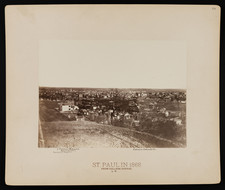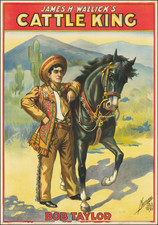Famous Propaganda Images for the Carlisle Indian School
Before and After Portraits of Tom Torlino, a Navajo Man
A pair of original photographs of a young Navajo man named Tom Torlino (Hastiin To' Haai), the first made in 1882, "as he arrived" at the Carlisle Indian School, in Native dress sporting long flowing hair, the second portrait from circa 1886, "3 1/2 years later" showing the same man with short, parted hair and dressed in a tailored suit. Interestingly, the mid-20th-century typewritten labels on the verso of each of the card mounts erroneously describe Torlino as a Chiricahua Apache, depicted in 1886 and 1889, respectively. The photographs, made by noted Carlisle photographer John N. Choate, are actually quite famous images and often reproduced in order to tout the Carlisle Indian School's ideas about Native American acculturation.
Tom Torlino, the name given to the Navajo man Hastiin To' Haai, entered the Carlisle School on October 21, 1882. He left on August 28, 1886. After leaving the school Torlino returned to his home in Coyote Canyon, New Mexico, picking up his career where it had left off, as a rancher and medicine man. In 1910 he resided in Tohatchi, New Mexico.
"Kill the Indian - Save the Man" Propaganda Images
These two photographs, purportedly showing what the Carlisle Indian School could do toward "civilizing" Native Americans, were notoriously used by the school in its propaganda efforts. The Carlisle Indian School was the project of Captain Richard Henry Pratt, erstwhile jailer of the Plains Indians imprisoned in Florida following the Red River War. With government backing he repurposed the old military barracks at Carlisle, Pennsylvania to establish the school in 1879. Historian Robert M. Utley has described Pratt as a combative spirit who railed against the reservation system:
Here [at the Carlisle Indian School], hundreds or even thousands of miles from the countervailing influences of tipi and wickiup, [Pratt] could truly experiment with the civilizing process. Dogmatic, stubborn, inflexible, outspoken, combative, and above all determined, Pratt championed his theories for a quarter of a century. He warred against the Indian Bureau and its entrenched bureaucracy, which he would have abolished, along with the reservations, had he been able... Pratt advocated sudden, total immersion... Pratt could display some impressive specimens of his work, and he did so regularly at world's fairs and other exhibitions - Utley, The Indian Frontier of the American West 1846-1890, pages 218-219.
Choate the Photographer
John Nicolas Choate is remembered for the photographs he made at the Carlisle Indian School. According to historians Barbara Landis and Richard Tritt, Choate may have manipulated the lighting in the so-called "after" portrait to cause Torlino's skin to appear lighter, thus emphasizing the point of the school: after going through Carlisle Native Americans could literally blend in with white society. Dickinson College has a collection of Choate's glass plate negatives.













![[Hermann's Battle] Die Hermann's-Schlacht](https://storage.googleapis.com/raremaps/img/small/83003.jpg)

![[Jonah Negotiating His Embarkation] Quid demens latebras circumspicis alterum in orbem. Si fugirs Dominum, non tamen effugies. Cui tellus paret, summus cui militat aether, Non parere putas huic etiam Oceanum](https://storage.googleapis.com/raremaps/img/small/85070.jpg)
